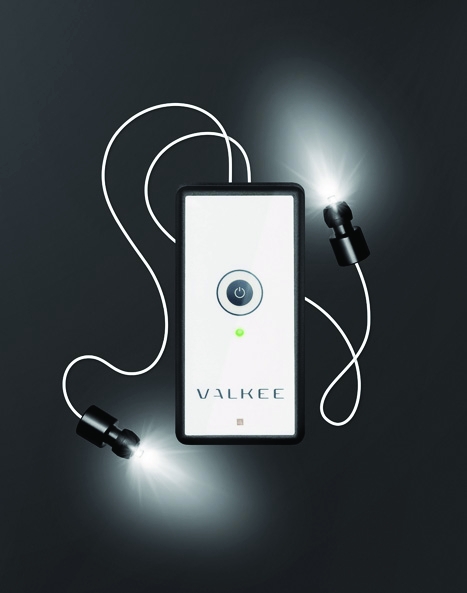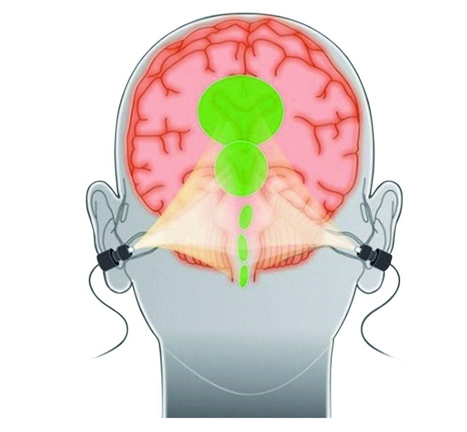Northern Finland in January isn’t a sunny place. The residents of Oulu, a small port town some 350 miles north of Helsinki, look forward to the winter snows because they brighten the place up. And, not surprisingly, many of them spend much of the winter down in the dumps.
Seasonal-affective disorder (SAD) is, of course, a recognised condition. As many as 25 per cent of people living in non-tropical latitudes are believed to suffer from a low mood when there is a shortage of natural light - interestingly, the condition is as prevalent at the latitude of Rome as it is in more northerly regions.

The technology-based answer to SAD is bright light therapy, which is as simple as it sounds - the sufferer shines a lamp designed to mimic the characteristics of sunlight at his or her face for a period of up to two hours a day. However, a company based in Oulu has devised a strikingly counterintuitive alternative. Rather than shining a light at your eyes, the company, called Valkee, has designed a device that shines light into your ears.
Now on sale in the UK, the Valkee device actually has a sound scientific basis, insists the company’s co-founder and chief scientist Juuso Nissilä. ‘My research as a physiologist at [Oulu University] has shown that the brain itself is sensitive to natural light,’ he said, ‘and the ear canal is actually a very efficient way to channel light directly to the surface of the brain.’
The Valkee story began in 2005, Nissilä said, when a childhood friend of his - former Nokia engineer Antti Auino - asked if he had any ideas of how to relieve SAD.
Nissilä, a physiologist, had studied the circadian rhythms of polar animals and their responsiveness to light, and had been involved in research that identified light-sensitive proteins on the surface of animal brains.
“There’s no evidence that shining light in the eyes has any effect on mood. But brain surface proteins are involved”
Juuso Nissilä, UOulu University
While Auino set about designing prototype devices that might exploit this physiological quirk, Nissilä began a scientific investigation. The genetic codes for a particular protein called OPN3, one of the same family of proteins as those found in the retina, had previously been identified in the brains of rats and in humans. But the protein itself, and its location in the brain, had not been investigated. Working with the biology department and Institute of Diagnostics at Oulu University, Nissilä used tissue-staining techniques to identify the protein in 18 separate regions of the human brain.

‘The proteins for nine opsin proteins are encoded in the human RNA, and four of those are found in the eye - one responds to dark and light, and the other three respond to colours,’ Nissilä explained. ‘These staining tests actually identified four of the other five opsins in the nerve tissue of the brain.’
It isn’t clear what these proteins do in the brain, but they seem to be associated with the nerve signalling pathways, as they are particularly abundant in areas that are involved with the production and storage of the neurotransmitter compounds serotonin, melatonin and dopamine - all of which are also implicated in mood, sleep and depression.
In fact, Nissilä believes, it’s these proteins that are responsible for the mood fluctuations associated with daylight, and not the eyes at all. ‘There’s no evidence that shining light in your eyes has any effect on mood,’ he claimed, ‘whereas we now have evidence that these brain-surface proteins are involved. Bone is actually quite a good transmitter of light - put a torch inside a skull and you’ll see the beam very clearly - so I now think that it’s the light reaching your brain surface through your skull which is the important factor.’
This means that shining light in via the ears is a far better way to deliver bright light therapy than staring at a lamp, he said. ‘There are two good reasons to use the ears,’ he said. ‘The first is that the skull is thin around the ear canal area, and a very good proportion of the light gets through. The second is that there are comparatively few blood vessels on the surface of the brain at that point.’
Blood, Nissilä said, is a strong light absorber, and the brain is covered with a web of fine blood vessels. The gap in the area around the ear canal means that the light from the Valkee device can reach the surface; moreover, the region of the brain in that area is responsible for serotonin processing. ‘This is one of the reasons we think we get a strong response,’ he said.
The Valkee device itself resembles a small MP3 player - a curvy white minimalist control unit with two earphones, each consisting of a white LED, mounted inside a rubbery earpiece. ‘The LED produces wavelengths close to that of sunlight, although the bluer wavelengths have the strongest effect,’ Nissila said. ‘The rest of the device makes sure that the intensity of the light remains constant throughout the treatment.’
“Shining light into the brain through the ears is a far better way to deliver bright light therapy than staring at a lamp”
Tests of the device have included fMRI, to see which areas of the brain are activated when light is delivered - showing that the regions involved with visual awareness, rather than perception, are activated. Unlike other bright light therapies, the Valkee unit has been tested in a placebo-controlled trial. ‘You can’t tell, when it’s in your ears, whether it’s on or not, so as long as it’s administered in a clinic, it’s possible to have a placebo,’ Nissilä explained.
The trial, with 26 patients receiving treatment and a control group of 23, showed that depression - measured using a questionnaire designed for psychological studies - decreased when the device was used for 12 minutes per day. ‘That’s as good, if not better, than conventional SAD treatment, but much quicker,’ Nissilä said. ‘And it may be more effective than pharmaceuticals for certain disorders.’
Valkee is currently conducting trials of the device for disorders involving the brain’s response to hormones, such as jet lag, migraine and cognitive performance, and more trials are planned for neural-signalling disorders, such as anxiety. However, sales results so far are promising; in its first year, the device cornered a third of the Finnish market for bright light therapy devices, despite a retail price of around €100.
So does Nissilä use it himself? ‘As a matter of fact I do,’ he told The Engineer, ‘although if I use it after about 8am I find it makes me a bit hyper. But I do use it for five minutes or so before I leave work, because I find it gives me more energy to play with my daughter.’
in depth
How the recession saw Oulu become a centre for technological innovation
Oulu is the largest town in northern Finland. It first found prosperity by exporting tar, the creosote-rich product of heating pine wood, for use as a waterproofing material for sailing ships. More recently, it has been the centre for the research and development activity of Nokia. But the recession has, almost paradoxically, seen it become a centre for technology entrepreneurship.
When Nokia was forced to lay off research staff, a large number of people with extensive skills in high technology and mobile communications found themselves in need of jobs. ‘Finland, traditionally, hasn’t had an entrepreneurial culture,’ explained Janne Mustonen of Business Oulu. ‘We were forced to change by circumstance.’
Innovative companies such as Valkee are supported by organisations such as the Foundation for Finnish Inventors. ‘A mere idea is just a percentage of an innovation,’ said Nissilä. ‘Creating an idea and breathing life into it is hard work, which requires the courage to encounter the prejudices of a larger audience and the risks and challenges of entrepreneurship.’
The foundation evaluates business ideas, advises on technical development, commercialisation and marketing, and helps to put entrepreneurs in touch with inventors.




Red Bull makes hydrogen fuel cell play with AVL
Formula 1 is an anachronistic anomaly where its only cutting edge is in engine development. The rules prohibit any real innovation and there would be...